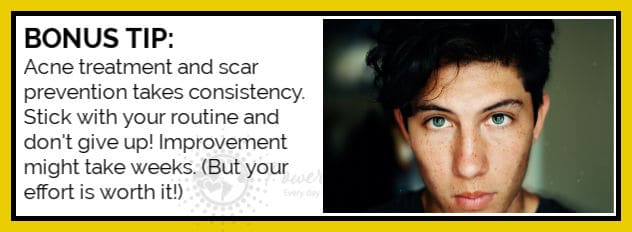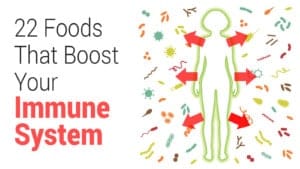Anyone who suffers from acne knows how painful and frustrating it can be. Unsightly breakouts deal some severe damage to your self-esteem. Additionally, the most severe acne can leave lasting scars on the skin that seem impossible to get rid of.
Nowadays, we see countless over-the-counter and prescription products that purport to help eliminate acne scars. Additionally, you may opt for pricey cosmetic treatments like microdermabrasion that claim to help resurface uneven skin. However, few realize that they probably have at least a few all-natural acne scar solutions sitting right in their kitchen cabinets.
Read on to discover some simple, easy, cost-effective ways of eliminating acne scars for good!
What Are Acne Scars?
Before we can determine how best to treat acne scars, we need to know what kind of scars we’re dealing with. Most people use the word “scar” to refer to any leftover inflammation or deeper lesions caused by breakouts. But in fact, the term isn’t one-size-fits-all.
A lot of what people refer to as acne scars are, in fact, something called post-inflammatory hyperpigmentation (or PIH): a flat discoloration of the skin that can range in color from pink to black with many shades in between. PIH affects men and women equally and can be seen in all skin tones. However, it occurs more commonly in those with darker complexions.
Because acne is a form of inflammation, it triggers the skin’s melanin-producing cells (or melanocytes) to make new melanosomes – essentially tiny grains of pigment. These melanosomes can result in visible discoloration long after the initial breakout has healed, and their color can be deepened by exposure to the sun. The worse the breakout, the more pronounced the PIH tends to be.
The good news is that because PIH is textureless, it can usually be covered up with cosmetic products such as foundation and concealer. It can usually also be lightened over time by avoiding sun exposure and using lightening agents such as hydroquinone.
Other Types of Scarring
The other types of acne scars include hypertrophic (or keloid) scarring and atrophic (or depressed) scarring. Hypertrophic scars result from the body producing too much collagen in its effort to heal acne. It triggers the growth of a raised mass known as a keloid. In contrast, atrophic scars arise from a loss of tissue in the skin’s surface, commonly due to acne sufferers picking at comedones or scabs. These small depressions in the skin resemble chicken pox scars and are commonly referred to as icepick or boxcar scars.
Unlike post-inflammatory hyperpigmentation, icepick and boxcar scars are much harder to conceal because they change the skin’s texture. Often, the appearance of scars like these can only be reduced by resurfacing the skin through treatments like microdermabrasion, chemical peels, micro-needling, dermal fillers, or laser treatment.
However, if you start treating your scars before they have a chance to heal fully, you can reduce your chances of needing more invasive treatments in the future. Let’s discover how!
Home Treatment for Acne Scars
The biggest key to avoiding acne scars in the first place is prevention. This means resisting the urge to squeeze or pop pimples or pick at newly forming scabs. It also means nourishing your healing skin with soothing home remedies.
In this section, we’ll explore a few of those remedies and the beneficial properties they have to offer.
1. Aloe vera gel
Most of us are familiar with aloe vera, and many of us even have aloe plants in our homes. Aloe vera gel is a common ingredient in many over-the-counter antibiotic ointments. It’s also a popular remedy for treating minor burns and sunburns thanks to the cooling sensation aloe gel provides when applied topically.
Because aloe has natural antibacterial and antifungal properties, it’s also highly recommended for treating cysts, small lacerations, and acne, as it helps to moisturize and fight infection as it heals the skin. If used regularly, there is evidence that it can also help prevent future breakouts by improving your skin’s resistance to acne-causing germs.
Though there is an abundance of aloe-based skincare products available in most drugstores and grocery stores, you can also extract the gel directly from the plant itself. Simply break off a leaf, squeeze, and apply the gel to the affected part of your skin. Repeat daily until the breakout has fully healed.
2. Honey
It’s a sweet treat you can stir into your tea, drizzle over some hot buttered toast, and even slather onto your skin. Honey is an underappreciated secret weapon in the fight against acne scars: it’s inexpensive, available in most supermarkets, non-toxic, and naturally antibacterial. It’s also a natural exfoliant, a moisturizer, and has been shown to help promote healing acne breakouts, eczema, and other skin afflictions.
Not all honey is created equal, however. If you plan to put it on your face, we recommend purchasing only raw, unpasteurized, organic honey. Processing kills much of the good bacteria that helps soothe and heal your skin, negating its medicinal benefits.
To help prevent acne scarring, simply apply a light but thorough coating of honey to any affected areas, and leave on overnight. To avoid making a mess, we recommend placing a towel over your pillowcase, tying back your hair, and – if possible – sleeping only on your back. This will allow the honey to penetrate your skin while you sleep and work its healing magic.
3. Coconut Oil
Another popular antifungal that you may have sitting right in your pantry is coconut oil. This multipurpose product has a huge array of uses, including makeup remover, moisturizer, hair conditioner, and acne scar preventer! However, there is an important caveat to keep in mind: if you know oils tend to block your pores when applied topically, you should probably avoid this one. Otherwise, coconut oil can be another great tool in your acne-fighting arsenal.
Coconut oil can be mixed with baking soda to form a thick paste that can then be applied as a mask. Before rinsing, rub in gentle circles and allow the gritty texture of the baking soda to act as a light natural exfoliant.
4. Apple Cider Vinegar
In recent years, apple cider vinegar has become an increasingly popular home remedy. Many naturopaths recommend drinking a few tablespoons diluted in water each day to help promote kidney and liver health by purging the body of toxins. A few cups poured over your hair in the shower will help encourage strength and shininess. And when diluted with water, it can also be swabbed onto the skin as a natural astringent.
Please take note that because apple cider vinegar is highly acidic, it can irritate sensitive skin and should only be used on acne scars that have fully healed. You should also not apply this product to broken or healing skin or newly forming scabs. Do not apply it directly to the skin without dilution, as the acidity can cause burning and irritation.
To make the most out of apple cider vinegar, dilute a few tablespoons in about a cup of water, dip in a cotton pad, and dab the solution onto fully healed skin. You can repeat this treatment every other day and follow it up with your favorite moisturizer.
5. Lemon Juice
Another highly acidic solution, lemon juice has long been touted as a home remedy for fading freckles. But did you know that lemons also deliver rich doses of alpha-hydroxy acid, a popular compound in many prescription and OTC acne treatments?
When used with care, lemon juice can help fade the hyperpigmentation that commonly follows acne breakouts. Squeeze the juice of a fresh lemon into some warm water. Then, use a cotton pad to dab it into fully healed skin. Be aware that the citric acid in lemons can be highly irritating. So you should avoid getting it into even superficial cuts or abrasions.
6. Zinc
If you take a look at your sunscreen, you’ll likely notice that zinc is one of the active ingredients. But did you know that zinc is also a powerful remedy for acne breakouts?
In addition to being a vital nutrient that your body needs to stay healthy, zinc is an anti-inflammatory. In fact, dermatologists commonly prescribe it to treat a range of skin conditions, including. Those include eczema, melasma, psoriasis, and acne. Some studies have shown that oral zinc can help improve the appearance of acne, while others recommend topical varieties for maximum therapeutic value.
The best use of zinc will vary from person to person. Some people see improvements from tablets administered orally. But others require zinc-based soaps or creams to start achieving results.
Most dermatologists recommend taking 25 – 30 milligrams by mouth daily to help heal problem skin. You can also purchase soap bars containing pyrithione zinc at your local health food store and wash once daily. This can help reduce the appearance of both face and body acne. Doctors commonly recommend shampoos and conditioners containing zinc to those suffering from dandruff. However, they also prove useful for those suffering from acne on the scalp.
 Final Thoughts on Managing Your Acne Scars
Final Thoughts on Managing Your Acne Scars
Acne can be incredibly hard to get rid of. Moreover, the scars can take a serious toll on your self-confidence. But with some information and the right products, you can start taking steps to fight acne and prevent scarring. Better even, you can achieve this with products you already have in your home. The journey to more beautiful skin starts today!












